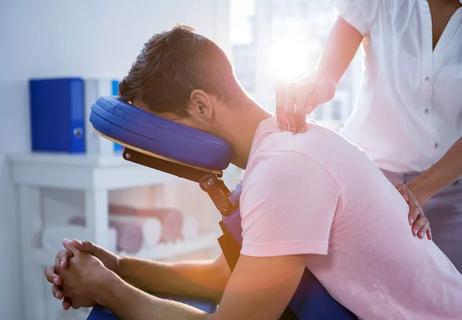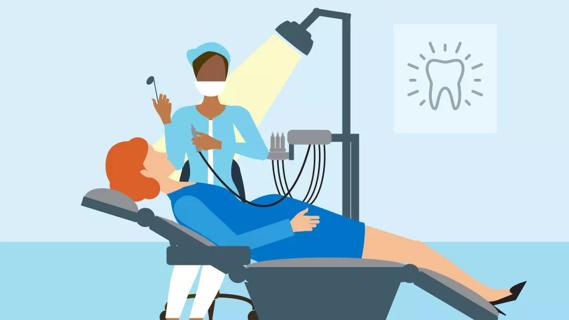Different from a regular massage, prenatal massages are gentle with light pressure

When you’re pregnant, taking time out for self-care is vital. That could mean relaxing on the couch with a favorite book or movie, or wearing a soft, comfortable tee shirt or pair of pants. Later in pregnancy, a massage can not only be soothing, but also offer multiple health benefits, such as alleviating pain, elevating your mood and even making delivery go more smoothly.
Advertisement
Cleveland Clinic is a non-profit academic medical center. Advertising on our site helps support our mission. We do not endorse non-Cleveland Clinic products or services. Policy
But what is a prenatal massage — and how is it different from a massage you’ll get at other times?
If you feel chilled out after having a massage, there’s a good reason for that. “Whether you’re pregnant or not, getting a massage may decrease stress hormones and enable you to start producing oxytocin,” says licensed massage therapist Nicole Cvitkovic, LMT. “This might also help with depression and anxiety.”
But having a massage during pregnancy looks and feels different from having a massage at other times. “A prenatal massage is generally going to be very light pressure — no more than a firm to medium pressure,” Cvitkovic says. “It’ll be more like a Swedish massage with very light stroking techniques, like kneading.”
In other words, don’t expect the kind of deep tissue massage you might be used to when you have a tough knot in your neck or shoulder. “The massage wouldn’t be enough to cause any discomfort, and it really wouldn’t feel like someone’s kind of digging at you,” Cvitkovic notes. “If a pregnant person does have blood clots or anything like that, deep pressure can potentially dislodge them.”
Prenatal massages generally last anywhere from 15 minutes to an hour. Although some massage therapists have special pregnancy massage tables with a hole cut out so you can lie down on your stomach, it’s generally safest to have a prenatal massage while lying on your side.
Advertisement
Cvitkovic says if you lie on your stomach or back, you run the risk of getting hypotension (or low blood pressure) or could inadvertently put unwanted pressure on nerves.
To make sure you’re comfortable and your body is aligned properly, massage therapists offer prenatal massage pillows, padded bolsters and other massage props.
“We have a bigger pillow to place under your belly, between the knees, generally underneath your head, and then a pillow for you to hug,” she says. “It’s almost like you have a giant body pillow to hang on to.”
Luckily, you don’t need to wear anything special for a prenatal massage. Whatever makes you feel most comfortable is the right thing to wear.
“Due to religious reasons, some people stay fully clothed or they put on a certain garment they need to wear,” Cvitkovic explains. “During a massage, you’re covered by sheets and a blanket, so some people completely dress all the way down. Others prefer to wear pregnancy drapes because they are more movable. Some people prefer to stay in their undergarments. It all depends.”
Cvitkovic says there aren’t necessarily multiple types of prenatal massage, but there are different prenatal massage techniques that therapists tend to use.
“They’re all very gentle,” she says. “They’re all very, very effective with pain relief and discomfort. They work very fast, but they are very gentle and slow movements.”
Prenatal massage offers many benefits, including pain relief and regulating certain hormone levels. “Massage can help regulate hormones like oxytocin and serotonin — things that make you a little bit happier,” says Cvitkovic. This can help improve your mood, as well as help you navigate depression and anxiety both during pregnancy and in the postpartum period.
These benefits can also be long-lasting. In fact, Cvitkovic says increased oxytocin production due to prenatal massage can also help improve labor outcomes. “Oxytocin is known to help improve labor contractions as well as influence your bonding with your baby,” she adds.
Other benefits include:
Despite benefits, people who are pregnant should be mindful of a few risks involving prenatal massage.
Your massage therapist should avoid putting deep pressure on your abdomen and legs. More specifically, they should also avoid the areas around your ankles and a few of your toes — namely your big, second and baby toes.
Advertisement
“Deep pressure can cause issues if you have blood clots,” Cvitkovic warns. “These places have little pressure points that migrate upwards. Pushing on them might increase blood flow.”
If a person who is pregnant has a blood clot, varicose veins or deep vein thrombosis, pressing on those areas can also increase complications, such as inducing labor or preeclampsia. “Avoiding those areas will definitely give you the least amount of risk for any of that to happen,” Cvitkovic affirms.
Although each person tolerates massages differently, Cvitkovic says doctors usually recommend people wait until after their 12th week of pregnancy to start getting a massage.
“Getting out of your first trimester especially is huge,” Cvitkovic explains. “You are at a high risk of miscarrying that early on, so you should postpone or limit massage as much as you can during that early timeframe.”
Once your pregnancy is into the second trimester, she recommends getting a massage once every two weeks. But later on in your pregnancy, you can get a massage up to once a week. “Your body’s going to be dealing with a lot more,” she notes. “Later on in the pregnancy, you can receive massage quite a bit more.”
There’s always the risk of having a miscarriage or preeclampsia with a regular massage. Issues like placenta accreta or an abruption are also possible serious complications. Edema, or swelling, is also possible in a certain area, especially if you get massages more often.
Advertisement
Changes in blood pressure can happen, too. “Sometimes, getting a deeper-pressured massage can cause your blood pressure to rise,” Cvitkovic says. “Sometimes, getting a massage with light pressure can actually lower your blood pressure.” Blood pressure changes are particularly important to look out for if you’re struggling to regulate gestational diabetes, she adds.
Most people will go to a spa for a prenatal massage — this kind isn’t very common in hospitals.
“Every massage therapist at a spa is medically licensed,” Cvitkovic explains. “They all perform medical massage.” However, there are traveling massage companies that can come to your home if you’re unable to get to a spa.
If you’re pregnant and wanting to get a massage, Cvitkovic recommends talking to your doctor beforehand. This also holds true if you’re actively trying to get pregnant or think you might be.
“If you’re planning to get pregnant or are in the process of trying to get pregnant, I would definitely get a doctor’s note, just to be on the safe side,” Cvitkovic says. “If someone who doesn’t know that they’re pregnant is getting a massage and they do happen to miscarry, you don’t want to be like, ‘Oh, the massage is what caused it.'”
Advertisement
But an occasional massage can be a great treat during pregnancy. “During pregnancy, so many things are limited — like you can’t eat certain meats and fish, you can’t have coffee, sodas and sugars, things like that. So, it’s not necessarily that you are limited on massage — it’s more so the pressure and techniques need to change. If you’re dealing with a lot of pain, a prenatal massage is extremely beneficial.”
Learn more about our editorial process.
Advertisement

The same things you do to treat sore muscles after exercise can help treat soreness after a massage

Focused on stretching and yoga poses, it can increase flexibility and ease back pain

These percussive devices can help relax muscles when seeing a masseuse isn’t an option

Foam tubes and rubber balls can help when you hurt

Medical massage can be tailored to your health needs and help you recover faster

Talk with them about their new sibling early and often

Dental care is not only safe during pregnancy, but it’s also highly recommended

Type 2 diabetes isn’t inevitable with these dietary changes

Applying a hot or cold compress can help with pain